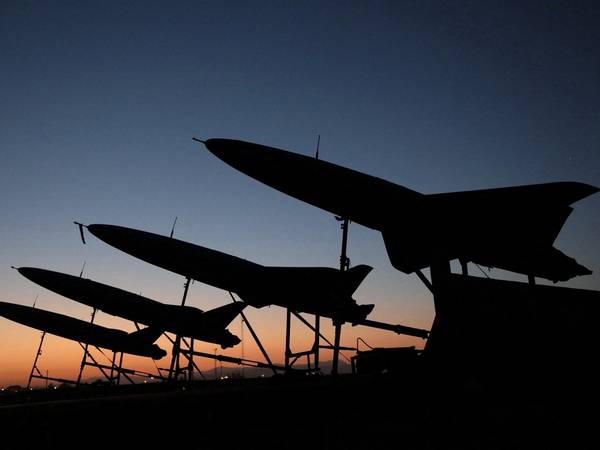Despite global sanctions, Iran has imported at least $236 million worth of aircraft and drone engine parts over the past 10 years from countries including Turkey, the UAE, Germany and even Ukraine and the US.
Data by the Islamic Republic's customs organization, scrutinized by Iran International, show that around $26 million worth of items listed as prohibited under the US Treasury's sanctions against Iran was imported to the country only in the first eight months of the current Iranian year, which started on March 21.
Earlier in the month, the head of a top unit at the US Department of Homeland Security said that "sensitive" materials are showing up overseas -- in Iranian weapons. "The Iranian drones that are being recovered on the battlefield in Ukraine, that are being recovered on the battlefield throughout the Middle East, they do have sensitive US communications systems and they have sensitive microelectronics," Jim Mancuso, the assistant director of the Global Trade Division at Homeland Security Investigations, told ABC News. Iran, China and Russia are all "attempting to illegally acquire" US technology, he added.
Although Iran has numerous tools to circumvent the sanctions, including manipulating the documents about its trade of sensitive know-how, data about import and export of drone parts are still decipherable in the official customs documents.
The multifunctionality of parts used to manufacture drones as well as outsourcing the production of some parts to private companies and using intermediaries to buy the materials, have all contributed to the failure of efforts to prevent the development of Iran's drone industry. According to security and military experts, one of the main reasons Western countries have not yet been able to curb the flow of foreign parts to Iran’s drone program is the multifunctionality of imported parts as it is unclear whether a particular part is used in a civilian crop-dusting aircraft or a military drone.
In June last year, the US Department of the Treasury issued a guide on Iran's drone industry. The 11-page “Guidance to Industry on Iran’s UAV-Related Activities” warned traders about items used by Iran in the manufacture of drones that may be subject to US sanctions. A table of 13 categories of items used in the production of drones included engines, navigational equipment, and electronics. The table listed the Harmonized Tariff Schedule (HTS) code, used internationally in customs information, and every traded item assigned a standardized international tariff code.
According to Iran’s custom organization statistics, a total of $236 million worth of “aircraft spark-ignition reciprocating or rotary internal combustion piston engines”, otherwise known as HTS 840710, were imported into the country from March 2012 to November 2023. The import of such products hit its lowest point in 1395 (the Iranian year from March 2016 to March 2017) at around $300,000, but the figure has been on rise ever since.
Following the Russian invasion of Ukraine, the import of these aircraft propulsion parts increased significantly, with the figure in the eight months ending in November exceeding that of the entire previous year. Seventy-five percent of the total imports in the 10-year timespan originated from Turkey ($52.8 million), Hong Kong ($50.9 million), the United Arab Emirates ($43.7 million), and China ( $28.8 million).
In addition to these primary sources, many European countries are also among the exporters of such equipment to Iran, most from Germany, followed by Ukraine ($2.1 million worth) and Slovenia.
While Ukraine has been exporting to Iran, the situation has now flipped, with Iran supplying drones and missiles to Russia to be used in the war on Ukraine. Reuters cited six sources as saying that Iran has provided Russia with around 400 powerful surface-to-surface ballistic missiles. Ukrainian President Volodymyr Zelenskyy said earlier this month that approximately 360 Iranian drones have been shot down in Ukraine since the beginning of January.
In February 2022, when Russia invaded Ukraine, Iran imported approximately $31,000 worth of parts and components of aircraft propulsion units used in drone manufacturing from Ukraine. Additionally, the United States also had a share in Iran’s procurement of drone parts, with more than $50,000 worth of equipment that took place in 2013 and 2018.
Iran went from being an importer to a global exporter, going from nearly none in 2020 to approximately $26 million in the first eight months of Iranian year 1402 (March to November 2023). Venezuela has been the first destination for the export of aircraft propulsion parts, with about $20 million worth of exports, which accounts for approximately 37% of the total exports of HTS 840710 items. Tajikistan follows with around $14.4 million, and Ethiopia with about $8.6 million.
Farzin Nadimi, a defense and security analyst and a senior fellow of the Washington Institute, said in an article in November 2022 that and Venezuela began their collaboration in the production of unmanned aerial vehicles in early 2000s. The collaboration progressed to the point where the Islamic Republic established a drone production line for Venezuela in 2012.
